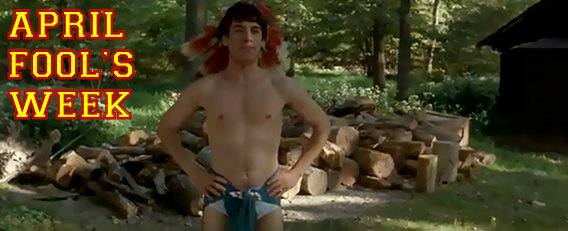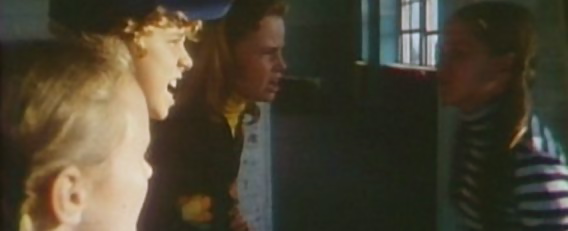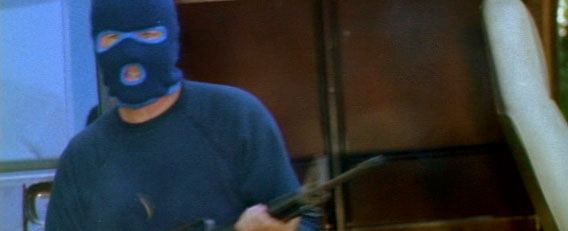
As Scream‘s token nerd Randy revealed, there are rules to surviving a horror movie. Although he would cover sex and drugs, there is another important point that he would neglect to mention… never, ever play a practical joke! With very few exceptions (Friday the 13th Part 2’s Ted being the most obvious example), this is a sin in the slasher film that is punishable by death. Whether it is a relatively harmless joke or one that results in a serious accident – often the catalyst for the carnage that follows – those who act idiotic or reckless are doomed. As John Kenneth Muir explained in his book Horror Films of the 1980s; “The practical joker serves a very useful purpose in the slasher film by setting up the false scares.” Not only are these characters used to provide comic relief during the bloodless sections of the movie, but their numerous jokes tease the audience with the occasional ‘jump,’ before the killer suddenly pounces from out of the shadows and strikes.
The archetypal practical joker is Friday the 13th‘s Ned, portrayed with a certain level of vulnerability by Mark Nelson. Utilising the ‘cry wolf’ tactic that would become a staple of the genre, Ned’s attempt to gain attention when his best friend, Jack, is spending quality time with his girlfriend, results in him pretending to drown in the lake as the group enjoy a leisurely afternoon swimming and sunbathing. As Brenda tries to perform mouth-to-mouth, Ned wraps his arms around her and tries to make out, much to the disgust of his friends. His various other gimmicks – such as firing an arrow into a target next to where Brenda is standing – soon begins to isolate him from his fellow camp counselors and when he is eventually murdered his absence goes unnoticed. Like many practical jokers, Ned uses his humour to hide his insecurities, often trying to portray himself as more confident than he actually is.
With Friday the 13th having provided the genre with its first traditional joker, perhaps it was inevitable that the character would be recycled for several of the subsequent sequels. In Steve Miner’s Friday the 13th Part 2, released the following year, the basic core of the group are recreated with new characters; lovebirds Jack and Marcie are replaced by Jeffrey and Sandra, who are joined by their comic relief friend Ted (Stu Charno). Although he would ultimately survive the movie due to remaining at a bar instead of returning to camp with the others, Friday the 13th Part 3‘s Shelly (Larry Zerner) would not be as fortunate. His desperation to be accepted by the group is taken to the extreme when he also fakes his own death, this time with the help of stage make-up. The wannabe actor tries to impress fellow gooseberry Vera by jumping out of the lake wearing a hockey mask but he only succeeds in angering the object of his affection. Predictably, he is killed soon afterwards and the murderer appears wearing his outfit, fooling Vera into believing it is Shelly. This practical joke not only costs him his own life but also that of Vera.

On several occasions the prank would take place at the beginning of the movie and would be the cause for the killing spree that would follow. Paul Lynch’s Prom Night, released the same year as Friday the 13th, opened with a seemingly harmless children’s game, in which a group of kids chase a young girl, Robin (Tammy Bourne), around an abandoned building as they repeatedly chant, “The killers are coming.” Backing her into a corner, Robin climbs onto the windowsill but slips and falls backwards through the window. The children, fearing that if the truth is discovered they will spend the rest of their lives in jail, vow never to speak about the incident ever again, but several years later they are hunted down one-by-one by someone seeking retribution for their crimes. Terror Train would also begin with a prank, this time by hiding a cadaver in bed and then convincing class nerd Kenny (Derek MacKinnon) that the body is really a girl, who is waiting to have sex with him. Upon discovering the corpse, Kenny has a breakdown and is institutionalised, returning years later to punish those responsible.
Hell Night, directed by x-rated filmmaker Tom DeSimone and starring horror veteran Linda Blair, would see four pledges of a fraternity forced to spend the night in the dreaded Garth Manon where, many years before, the master of the house had allegedly butchered his entire family. In an attempt to scare the pledges and convince them to leave, ringleader Peter (Kevin Brophy) sneaks onto the grounds and, with the assistance of two of his friends, tries to fool the group into believing that the house is haunted, although the joke ultimately backfires when Peter and most of the pledges are killed. On rare occasions the practical joker is a child, as with Romano Scavolini’s notoriously sleazy Nightmare (also known under its more infamous title Nightmare in a Damaged Brain), in which young C.J. (C.J. Cooke) staggers into the room covered in ketchup, pretending to have been stabbed. His punishment is somewhat less severe than his teenage counterparts, as he is sent to bed by his mother.
Sometimes the jokers have a reason for their cruel prank, with teenagers at Camp Blackfoot in Tony Maylam’s The Burning getting revenge against their creepy caretaker, Cropsy (Lou David), by leaving a worm-ridden skull by the side of his bed lit by candles, but when Cropsy wakes up and panics, the candles cause his bed to set alight and he is severely burnt. Having undergone unsuccessful treatment, Cropsy returns to the camp years later to kill those responsible. In an interesting twist, one of the survivors at the end of the movie was in part responsible for the initial prank that had been played on Cropsy. Another retaliation against a bully was in Mark Rosman’s 1983 thriller The House on Sorority Row, in which domineering house mother Mrs. Slater (Lois Kelso Hunt) pushes her young sorority girls too far, prompting the promiscuous (Vicki) Eileen Davidson to pull a gun during a prank and shoot Slater. Believing her to be dead, they dump the body in the filthy swimming pool but when they go to retrieve it they discover that she has disappeared.

One of the more elaborate pranks was in Jimmy Hutson’s 1981 slasher Final Exam, in which a fraternity at Lanier College stage a terrorist attack (driving onto the grounds in ski masks and opening fire on students, although these are later revealed to be fake bullets), in order for one of their members to cheat their way out of an exam. The British-shot Slaughter High was produced in 1984 under the title April Fool’s Day but by the time of its release two years later, Paramount had already announced plans to distribute a movie with the same title and so the picture was renamed. Much like Terror Train, the film began with a cruel prank played on the class nerd, with Marty (Simon Scuddamore) left deformed after his school lab is set on fire. Inviting the guilty to a reunion ten years later, Marty takes vengeance on his former classmates for the taunting and ridicule he had suffered as a child.
The aforementioned April Fool’s Day took inspiration from Agatha Christie’s And Then There Were None by having a group of teens staying on a remote island for the weekend owned by their friend, Muffy (Deborah Foreman). But as the friends begin to disappear, suspicion falls on their host, although in a surprise twist the entire vacation has been nothing more than an experiment for a ‘murder whodunnit’ tourist attraction that Muffy is hoping to launch. William Fruet’s Killer Party, released the same year and written by Friday the 13th: The Final Chapter‘s Barney Cohen, saw a group of coeds stalked in the fraternity house where a fatal accident had occurred many years earlier. Much like Slaughter High and April Fool’s Day, Fruet and Cohen chose to focus as much on the comic aspects of the premise as the horror, although this decision would divide fans of the genre.
“If you turn the corner and your chunky prankster friend is lying in a pool of his own blood, don’t scream, he’s just faking it. Unless of course he’s already pulled this prank once today, in that case, yeah, he’s dead… and so are you,” stated a BloodyGoodHorror article from 2007 entitled 10 Tips for Surviving a Slasher Movie. As with every other aspect of the genre, the practical joker soon became formulaic and a token element of the traditional slasher. They are irritating, immature and predictable, but the fact that their pranks are born out of a longing for attention makes them somewhat sympathetic and their deaths all the more tragic. The practical joker provides some much needed comic relief, a few minor scares and are often the most developed of all the characters, making them an integral part of the genre.


5 Responses to Killing Joke: Pranks in Slasher Movies